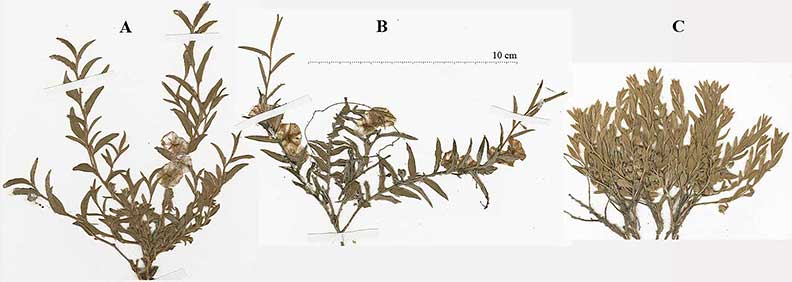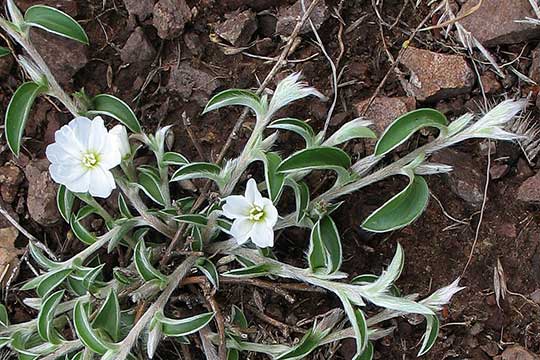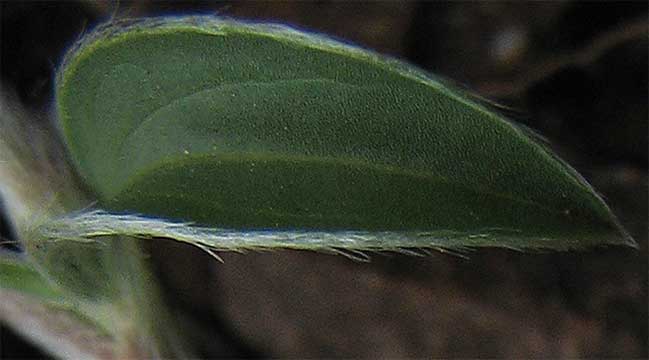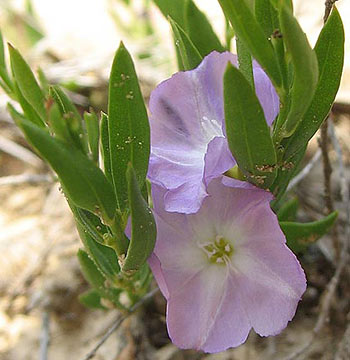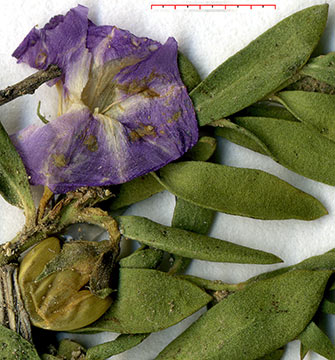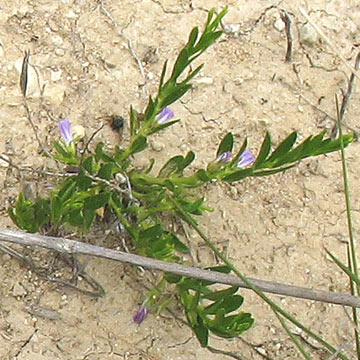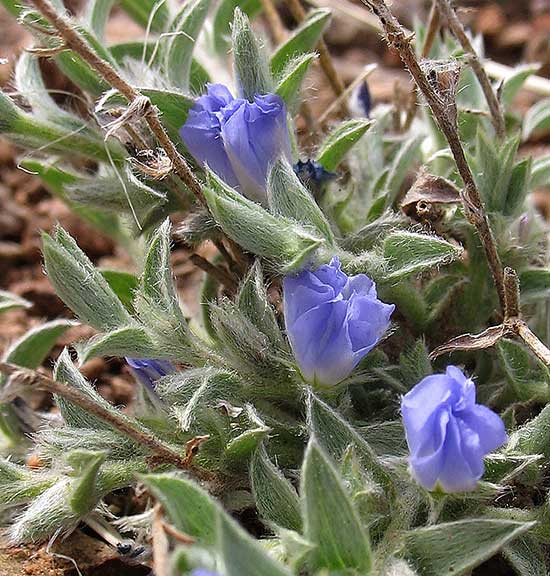
Evolvulus sp. in bloom, Davis Mountains, 28 April 2007
But which species? In the text below it will be referred to as ‘E. sp?’
Identifying Evolvulus across Texas
A Critical Survey of Available Keys
by Bob Harms ( )
)
A 'Pan-Texas' Key
L. H. Shinners' 1970 key for Evolvulus [in D. S. Correll & M. C. Johnston (eds.), Manual of the vascular plants of Texas] presents:
1. Corolla 5–8 mm. across, bluish–white to deep blue …
E. alsinoides
1. Corolla 8–18 mm. across, white to lavender (2)
2(1). Leaf blades densely pilose on both surfaces with loosely appressed to spreading hairs … E. nuttallianus
2. Leaf blades densely pubescent beneath with closely appressed hairs and commonly some loose ones as well, glabrous or loosely pilose above. … E. sericeus
Additionally, in the text we find corolla colors for the latter two as
E. nuttallianus: lavender to almost white;
E. sericeus: white.
Working with photos is not easy. The flowers of ‘E. sp?’ are not open, and no scale is given – but the color is better on a photo than with a dried, pressed specimen. If we assume the corolla width to be greater than 8 mm, since, as we shall show below, it is not E. alsinoides, the upper leaf surface is not glabrous and the blue flower (although not exactly lavender) might seem to lead to E. nuttallianus.
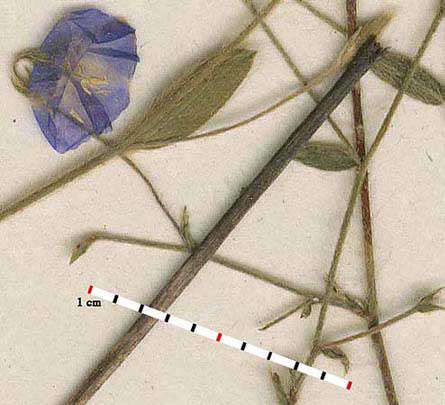
Jim Hogg Co.
Peduncle longer than subtending leaf;
Corolla 5.5 mm in diameter.
(W.V. Brown 73-9-29A [LL])
|
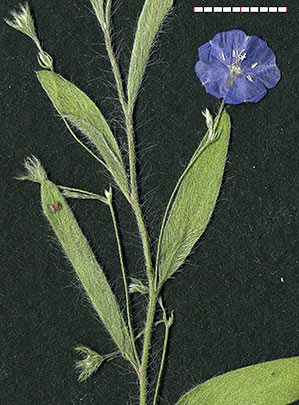
Davis Mountains, Jeff Davis Co.
Peduncle shorter than subtending leaf
Corolla 9.2 mm in diameter.
(R.T. Harms 110 [TEX])
|
| E. alsinoides long peduncles and cymes
|
Keys for the Desert Southwest (Trans-Pecos Texas, Arizona, New Mexico)
J. Henrickson's key (unpublished) for the flora of the Chihuahuan Desert employs peduncle form, flower color & size, and leaf vestiture:
A. Fls. borne on distinct, slender, filiform peduncles 1–2(–4) cm long; corollas blue and white, 5–9 mm in diameter; lvs. never glabrous above … 1.
E. alsinoides
AA. Fls. sessile or short pedicillate in the lf. axils, (
very rarely long pedunculate as in
E. alsinoides, but if so with the upper lf. surface glabrous); corollas mostly white to lavender, 9–18 mm in diameter; lvs. sericeous or glabrous above.
B. Lvs. densely sericeous on both surfaces with appressed, spreading hairs … 2. E. nuttallianus
BB. Lvs. glabrous on the upper surface, densely sericeous on the lower surface … 3. E. sericeus
Additionally, in the text we find corolla colors for the latter two as
E. nuttallianus: lavender blue to white at the throat or in a star–shaped pattern or white throughout;
E. sericeus: white.
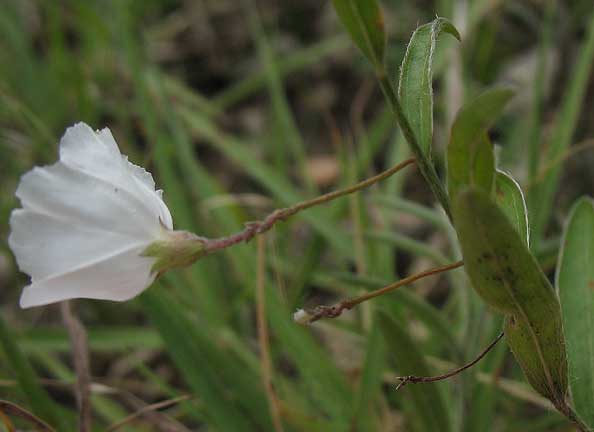
E. sericeus long peduncles; Real Co., Texas
Although the peducles are long, the upper leaf surface is glabrous.
Given the Chihuahuan locale, this key might seem more appropriate for ‘E. sp?’. Even if we don't know the exact diameter of the flowers, they are not on long peduncles, clearly ruling out E. alsinoides. And the upper leaf surface is pubescent (sericeous, although questionably dense), and not glabrous; and the corolla is not white.
So ‘E. sp?’ would seem to be E. nuttallianus. And this is how similar specimens from Texas and adjacent Mexico have often been treated [BH: incorrectly] in herbarium collections, which in turn have been the basis for the species descriptions — and as a consequence the lack of agreement on the occurrence of E. sericeus (including E. discolor) and E. nuttallianus in the Trans–Pecos. A good example of this is a 1940 collection sheet from the Big Bend authority Barton Warnock (shown below, edited to remove empty space), from Brewster County, with two specimens both identified as E. pilosus (= E. nuttallianus). But as correctly annotated by the Convolvulacea expert C. A. O'Donell in 1953 (red outline boxes), only the plant on the left is E. pilosus; the plant on the right being E. discolor (with pubescent upper leaf surfaces). [See also the quiz set at the bottom of this page.]
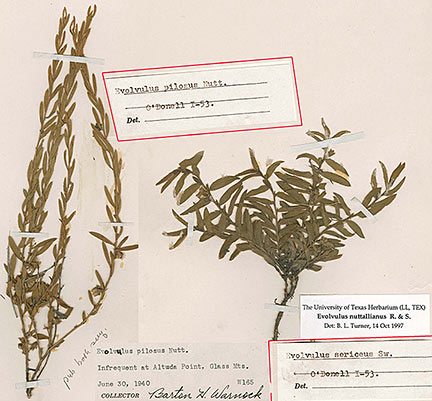
[Click for large image.]
Compare the USDA mapping of these two species (with notation by Harms) with that of BONAP's North American Plant Atlas. The USDA map, which shows no E. sericeus for Brewster or Presidio Counties, would seem to be based on the 38 collections of E. nuttallianus/E. sericeus in TEX/LL. My 2015 evaluation of these 38 specimens has determined that all collections from Jeff Davis Co. are E. discolor (i.e., no E. nuttallianus) and that 10 of the purported 22 'E. nuttallianus' collections from Brewster & Presidio are E. discolor. My determinations have been established by leaf clearing and other clear differentiae.
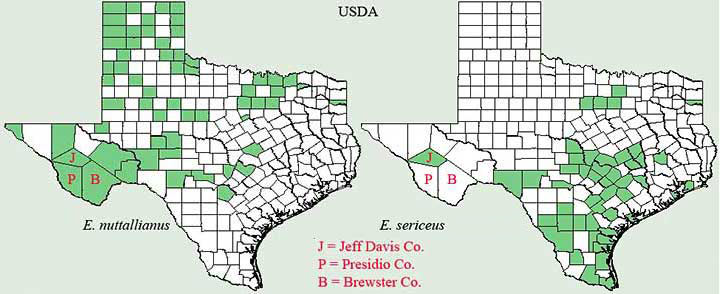
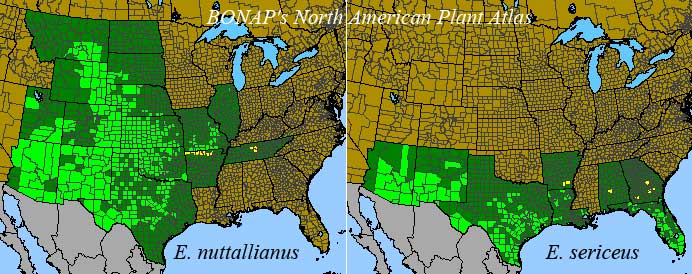
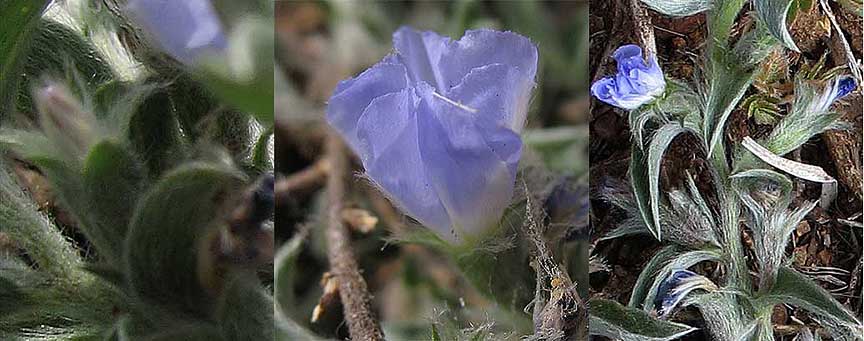
Oblong–lanceolate (Ovate–lanceolate) sepals on ‘E. sp?’ (above).
‘E. sp?’ as E. sericeus
D. F. Austin, Vascular Plants of Arizona (1998), employs only peduncle and sepal form for the Texas species,
but includes corolla width and other features to distinguish Arizona species:
1. Peduncles filiform, longer or shorter than the subtending leaves.
2. Corolla (5–)7–10 mm wide;... (other features) … E. alsinoides
2’ Corolla (10–) 12–22 mm wide; ... (other features) … E. arizonicus
1’ Peduncles absent or very short and stout,
always shorter than subtending leaves.
3. Sepals lanceolate to narrow–lanceolate, 4–5 mm long, spreading villous … E. nuttallianus
3’ Sepals oblong–lanceolate, 3–5 mm long, appressed–pilose … E. sericeus
Additionally, the text descriptions account for the pubescence and color of ‘
E. sp?’ (above) —
would seem to determine it to be E. sericeus; i.e.,
- for E. nuttallianus: leaves ... densely pubescent on both surfaces ... flowers ... corollas ... purple or blue;
- for E. sericeus: leaves ... densely pubescent below, glabrous or pubescent above ... flowers ... corollas pale blue, pale violet or white.
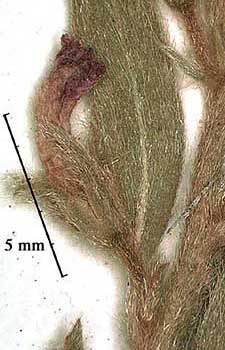 |
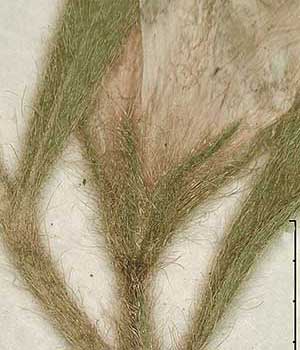
|
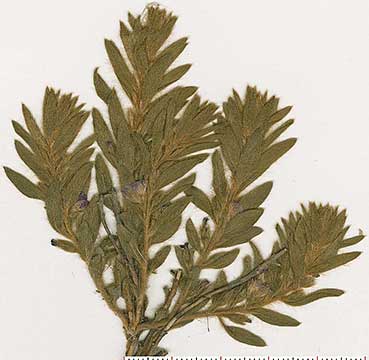
|
E. nuttallianus narrow–lanceolate (linear–lanceolate) sepals;
Culberson Co. (C. H. Muller 8255 [LL]; (left),
Dallas Co. (C.L. Lundell & A.A. Lundell 10618 [LL]; center)
|
E. nuttallianus appressed to ascending leaf habit;
Roosevelt Co., New Mexico (J. Secor 12 [TEX])
|
‘E. sp?’ as E. sericeus var. discolor
W. C. Martin & C. R. Hutchins, A Flora of New Mexico (1981), recognize several additional distinctive characteristics.
For one, they recognizes differences of habit, which I have found to be an extremely useful first approximation. [Note: Their E. pilosus (generally considered an invalid name) is a synonym for E. nuttallianus.]
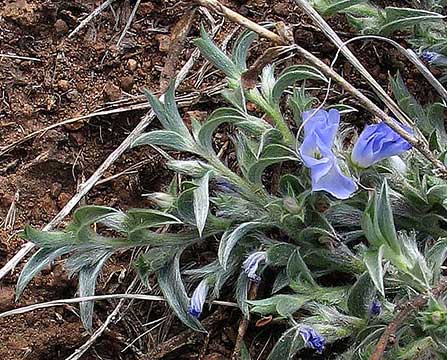
|
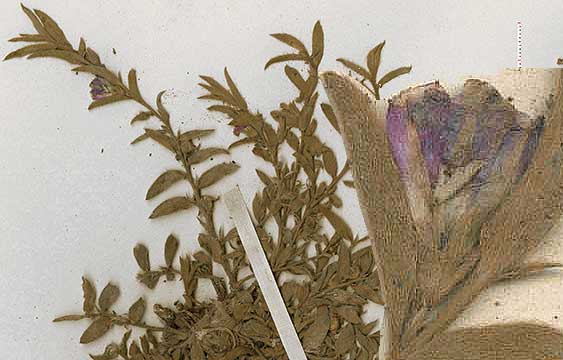
|
Spreading leaf habit of ‘E. sp?’ (left) & Brewster Co. specimen (right).
[Note especially the falcate leaf form typical of this species.
Colors recognized for E. sericeus type by van Ooststroom (p. 129) include "white, lilac or pale blue, occasionally yellow in dried state."]
|
1. Stems erect or ascending; upper leaves much smaller than the lower ones ⇒
E. alsinoides, E. arizonicus var
arizonicus, E. arizonicus var
laetus
1. Stems prostrate, decumbent, or spreading; upper leaves not much smaller than the lower ones … 4
4. Leaves appressed to narrowly ascending; sepals linear to linear–lanceolate … E. pilosus
4. Leaves spreading; sepals lanceolate to ovate–lanceolate … 5
5. Flowers blue; upper surface of the leaves grayish–sericeous … E. sericeus var. sericeus
5. Flowers creamy–white; upper surface of the leaves green and glabrate … E. sericeus var. discolor
In the description for
E. sericeus var.
discolor ‘glabrate’ is replaced with ‘glabrous or glabrate.’
This key leads us to ID ‘E. sp?’ (above) as E. sericeus var. sericeus, but the distinction of the two varieties as given by Martin & Hutchins, with reference to flower color, is not generally accepted. E. sericeus var. discolor (Benth.) Gray (1878) did not mention flower color. The adjective discolor refers to the two faces of a leaf being unlike in color (i.e. leaf surface vestiture).
The standard reference for Evolvulus, S. J. van Ooststroom's 1934 monograph, gives the following description of E. sericeus var. discolor:
Leaves
- 2—4 times as long as broad,
- bright green and glabrous above, densely sericeo–villose beneath like the stems, or densely sericeo-villose on both sides
- often conduplicate, especially the higher ones,
- convex and falcate;
- midrib and 2—3 pairs of lateral nerves, rising from near the base, impressed above, slightly visible beneath;
Corolla
white, or
pale-blue
In other words ‘E. sp?’ seems close to a blue–flowered var. discolor. A much clearer match is a white flowered specimen photographed the next day a little over a mile away on the same ranch — with conduplicate, falcate leaves having a glabrous upper surface, and a midrib with 2 pairs of strong secondary lateral veins from the very base (basal acrodromous venation). I have argued that such plants represent a distinct species S. discolor Benth., and not a variety of E. sericeus.
But apart from flower color and upper leaf surface (and longer internodes) this plant has essentially the same form as ‘E. sp?’ (above).
The key of T. H. Kearney, R. H. Peebles et al., Arizona Flora (1951) is rich in detail.
1. Stems rarely more than 15 cm. long, spreading or decumbent; upper leaves only slightly reduced; flowers mostly solitary; peduncles or pedicels
much shorter than the subtending leaves, often decurved in fruit (2)
1. Stems commonly 30 cm. or longer, erect or ascending; upper leaves greatly reduced; flowers one or a few on very slender, bracted peduncles longer than the subtending leaves. Inflorescence a very open, leafy, terminal panicle; corolla rotate, azure blue or occasionally white (3)
2. Sepals linear or narrowly lanceolate; corolla rotate campanulate, lavender, drying violet purple; leaves appressed or narrowly ascending, closely imbricate along the stem, at least above, densely villous-sericeous on both surfaces … 1. E. pilosus
2. Sepals laceolate or ovate lanceolate; corolla rotate, cream-colored or azure blue; leaves spreading, not closely imbricate along the stem, commonly glabrous on the upper surface … 2. E. sericeus
3. Corolla not more than 7 mm. in diameter … 3.E. alsinoides
3. Corolla 8 to 20 mm. in diameter … 4. E. arizonicus
In the description for
E. sericeus they note [emphasis mine]:
The common phase in Arizona is var. discolor (Benth.) Gray ... This has the upper leaf surface green and glabrate, and the corolla usually cream-colored. The phase with leaves sericeous on both surfaces is occasional in Cochise County.
A new Evolvulus key for Sonora also uses habit to distinguish the two taxa currently recognized.
R.S. Felger, D.F. Austin et al. (Convolulaceae of Sonora, Mexico I, J. Bot. Res. Inst. Texas 6 [2012]; I assume the Evolvulus section was prepared by Austin) also include leaf arrangement as a distinguishing feature (following van Ooststroom):
3. Pedicels absent; flowers solitary (usually) in leaf axils.
4. leaves markedly distichous. Sepals1 lanceolate to narrowly lanceolate, spreading pilose … E. sericeus
4. leaves usually not distichous. Sepals1 oblong-lanceolate, appressed-pilose … E. nuttallianus
1Note that the sepal characters for these two taxa have been reversed in their key, but are correct in their text.
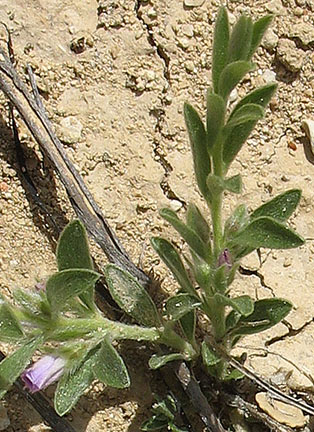

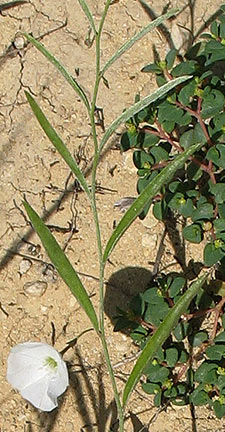
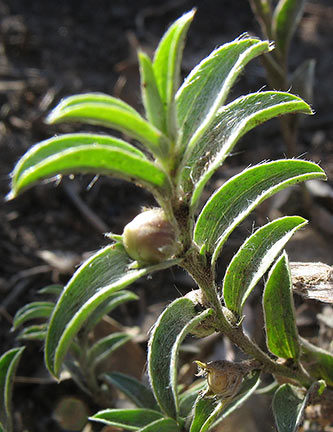 Non-distichous E. nuttallianus (left 2) — distichous E. sericeus (center) & E. discolor (right). [Click image for a larger view]
Non-distichous E. nuttallianus (left 2) — distichous E. sericeus (center) & E. discolor (right). [Click image for a larger view]
I consider the recognition of distichous leaf arrangement, two vertical rows on opposite sides of the stem, an important contribution. But this is often difficult to discern with pressed specimens from desert areas with short internodes. I sense that Austin's qualification (hedge) of that feature (‘markedly ’, ‘usually ’) may result from the many E. discolor collections that are currently identified as E. nuttallianus. (Note Austin's view that E. oreophilus, repeated in their 2012 treatment, is a synonym of E. nuttallianus.)
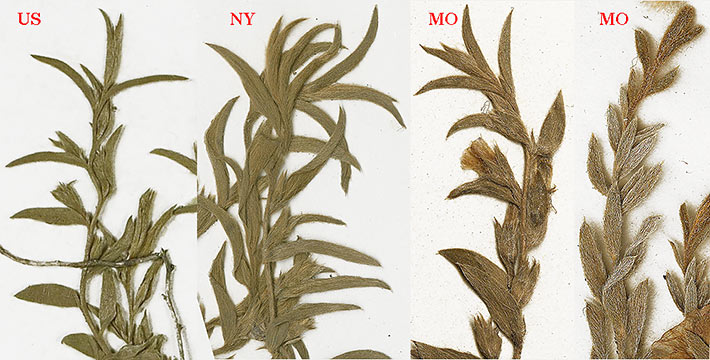
E. oreophilus stem tips at herbaria US (lectotype), NY, MO (isotypes) plus one at MO that is actually E. nuttallianus (and not an isotype)
Conclusion & Critique
The keys developed for the Southwest west of Texas, support my identification of our ‘E. sp?’ as not E. nuttallianus, but these collections are also not E. sericeus var. sericeus, but rather E. discolor.
Data from Texas east of the Trans-Pecos doesn't fare quite as well with the above treatments.
- Vestiture of leaves, sepals, stems is not as distinctive as keys/descriptions indicate. The pictures below are from a population of E. nuttallianus in N. Hays Co. (Texas). These totally lack pubescence. (Voucher Bob Harms 43–A [TEX]). Cf. Variation in Evolvulus nuttallianus - Phytoneuron 2014-91.
I find it somewhat ironic that this page began with a form of Evolvulus that is commonly misidentified in Texas because both leaves are pubescent; and perhaps even more ironic that its earlier species name even in limited use today (although an invalid, not just older name) was ‘pilosus.’ – ‘hairy.’
- Peduncle form does not always suffice to distinguish E. sericeus (2 examples below) from E. alsinoides (see examples above).
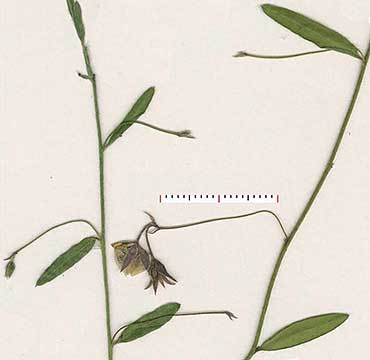
E. sericeus, Hays Co. (R.T. Harms 94 [TEX])
|
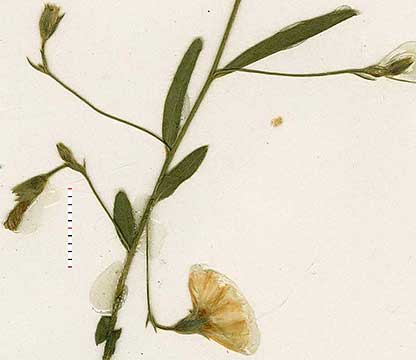
E. sericeus, San Patricio Co. (G.G. Williges 402 [TEX])
|
The existence of E. sericeus forma peduculatus recognized by van Ooststroom apparently did not receive much attention (as seems to be the case with much of the rich descriptive detail in his monograph). This form is not 'rare' as noted by Shinners in Correll & Johnston, but is the common form from Hays Co. to Val Verde Co., and extending to the south, even into Mexico, as well. Its geographical distribution could possibly lead to its being upgraded to ‘variety’ status. In N. Hays County I searched in vain for it with early spring flowers, but then in July nearly all plants of that same population exhibited long peduncles. Travis County collections have both long and short forms. Sometimes both forms are present on the same plant or on the same herbarium sheet. But in other areas peduncles are consistently absent.
- When long, the peduncle diameter of E. sericeus is not consistently 'stouter' (Cf. D. F. Austin key), less filiform (cf. Henrickson), or less slender (cf. Kearney et al.) than that of E. alsinoides.
- Although the peduncles of E. sericeus are typically the same length or shorter than their subtending leaves, it are not predictably shorter than subtending leaves' (cf. D. F. Austin key). Note the longer peduncles in the above two images from quite different areas.
However, one geographical limitation is that the forma pedunculatus occurs only east of the Pecos River, i.e., never with E. discolor, and with forms that always have glabrous upper leaf surfaces. Henrickson finesses this problem with a conditional:
"very rarely long pedunculate as in E. alsinoides, but if so with the upper lf. surface glabrous"
The relationship with subtending leaf length may be a 'typical' feature, but it is not diagnostic.
A Final Quiz
Three Evolvulus specimens in the TEX herbarium are shown below, labeled A, B, C. Two of these have been determined by experts to be the same species. Given the above keys, you should now be able to figure out which two are said to represent the same species. Placing the cursor over the plant will give the identifications. [Click here for a larger view.]
